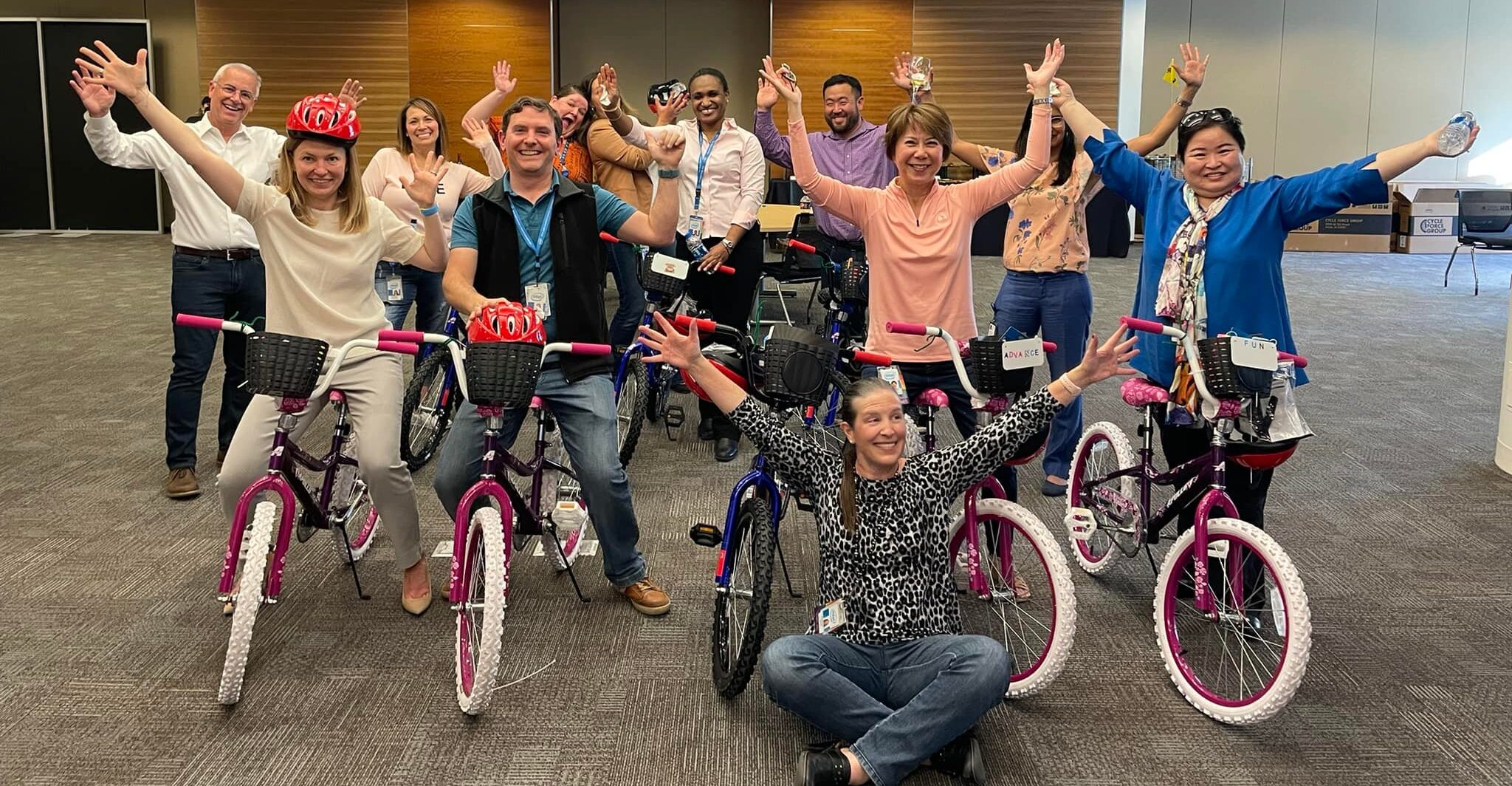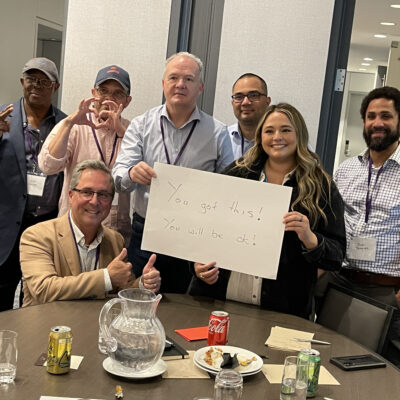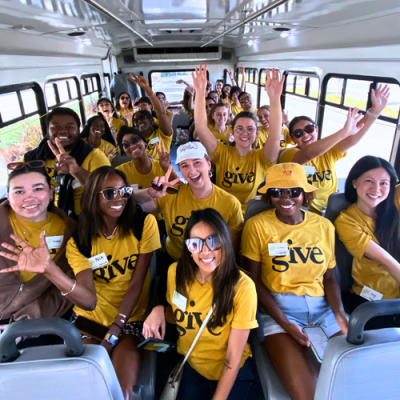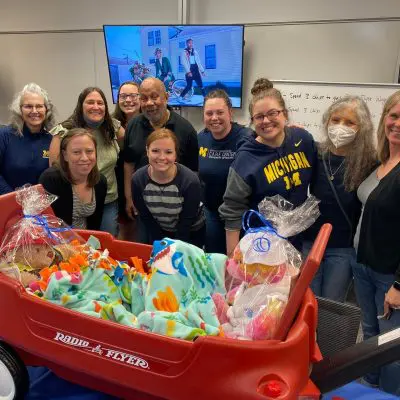You thought it’d be just another team event. But by noon, you’re helping build prosthetic hands, laughing with coworkers, and realizing you’re part of something bigger. This is what corporate social responsibility should feel like.
TeamBonding has worked with 80% of the Fortune 100 companies (yes, really), and in my almost 20 years here, I’ve seen that, when done correctly, corporate charity events truly do transform both communities and workplace culture.
In my recent webinar, I gave attendees the secrets to creating engaging Corporate Social Responsibility (CSR) events:
In this article, I’ll dive deeper into why charitable events are a secret weapon for employee engagement, how they build stronger teams, and provide practical strategies for implementing them into your organization.
The Business Case for Charitable Events
There’s something special about how charitable events can boost morale, strengthen your company culture, and truly help other people, all at the same time.
But instead of jumping right into a list of all the benefits of CSR strategies, let’s start with some numbers that tell a pretty compelling story:
- Disengaged Employees Are Costly: A staggering $9.6 trillion in global productivity is lost annually due to disengaged employees, according to Gallup.
- Society > Businesses: 88% of people say it’s unacceptable to profit at the expense of society.
- Volunteering Makes Employees Happy: 93% of employees who volunteer express happiness with their employer.
- People Want Purpose: 93% of employees believe companies must lead with purpose.
The story being told here is one of disengaged employees becoming the norm, and it highlights the fact that giving back to others helps solve the problem.
Charitable Events Build Stronger Teams
Charitable events are so much more than feel-good activities that check boxes; they’re important investments in employee engagement and retention.
So, let’s take a closer look at the link between CSR, employee engagement, and corporate success.
When your company takes time for regular charitable team building events, you’ll start to:
1. Create Shared Purpose Beyond Profit
Old-school team building often seemed forced or artificial, but that’s not how TeamBonding does things. Our entire catalog is designed to connect people, teach them new skills, and make sure they have fun!
Our charitable events tap into the human desire to make a difference. When your team works together to build water filters for communities in need or assemble care packages for military personnel, they’re not thinking about daily tasks, they’re united by purpose.
This creates what I call “purpose bonds,” or connections that extend beyond the office walls.
Long story short? Teams that give back together also grow together, stay together, and win together. And the trust built through these experiences translates to improved collaboration and productivity.
2. Break Down Silos
Another big benefit of corporate charity events is how they can bring employees from different departments, locations, and levels of seniority together and help them form connections.
During our Prosthetic Hand Project, I’ve seen C-suite executives work with entry-level employees, connecting and creating memories while they work toward the same goal: creating functional prosthetics for those who need them!
By breaking down silos, you’re opening the door to innovation and stronger internal networks.
Likewise, if your marketing team works alongside the engineering department to build bicycles for underprivileged children with our Charity Bike Build, they won’t just be assembling bikes—they’ll be building understanding, respect, and memories.
3. Develop Leadership Skills in Action
Corporate charity events have a way of helping emerging leaders shine, get discovered, and step up in low-stakes, high-impact environments.
Unlike traditional leadership development programs, which sometimes feel intimidating or forced, these experiences allow natural leaders to emerge organically because everyone is working toward a meaningful goal.
This is what helps quiet team members become champions, and it happens when they’re passionate about a cause.
Trust me, the skills developed during these events—empathy, communication, problem-solving, etc.—directly translate to improved workplace performance.
The IMPACT Framework: Designing Effective Charitable Events
After years of creating and planning successful charitable events, I’ve developed a framework that ensures maximum engagement and impact. We call it the IMPACT Rule:
- I – Invite Employee Voices: Successful events start with listening. Ask your team about causes they care about, preferred event formats, and timing constraints. When employees are heard during planning, enthusiasm skyrockets.
- M – Measurable and Scalable: Set clear and quantifiable goals. Whether it’s assembling 100 hygiene kits or raising $5,000 for a local shelter, measurable goals give teams something concrete to work toward (and celebrate) together.
- P – Purpose-Aligned: Look for causes that relate to your company and its values. For example, a healthcare company participating in our Operation Cancer Care program or a tech firm doing the STEM Speedway event creates authenticity that employees can feel.
- A – Across-Team Connection: Design activities that naturally unite people who don’t typically work together. Mixed-department teams and collaborative challenges break down organizational barriers.
- C – Create Tangible Outcomes: People want to see their impact. Share photos of completed projects, stories from beneficiaries, and concrete measures of success. This visible impact fuels continued engagement, reflection, and pride.
- T – Tell the Story: Document and share the journey. Create photo boards, compile employee reflections, and show the ripple effects of your efforts. These stories become powerful tools for recruitment, retention, and brand building.
I’ve found the IMPACT framework to be almost as important as implementing a solid CSR strategy because it’s not just about checking boxes, it’s about how you approach the act of giving back.
We invited webinar attendees to vote on where they stood with each factor of the IMPACT framework, with many admitting to struggling with measuring success and inviting employee voice. But don’t worry, I’ll cover that in this blog!

It’s important to make it clear that you’re not just getting involved with philanthropic team building ideas to make your brand look good—show your team that you care about them and the community, and then keep them involved through the whole process.
About the Pyramid of CSR
The Pyramid of corporate social responsibility was developed by Professor Archie Carroll in 1991 to help explain his four-part definition of CSR. From the bottom or foundation up to the top, here’s what the pyramid includes:
- Be economically profitable: This is the foundation of the pyramid. To achieve success in the other areas, your business needs to be financially stable. This should not, however, be at the expense of the following three responsibilities.
- Obey the law: This is the second layer of the pyramid, but arguably the most important. Your business must comply with all relevant laws and regulations to ensure operations are conducted fairly.
- Be ethically responsible: This is the third layer of the pyramid. It refers to doing the right thing and following ethical guidelines to fill in gaps and ambiguities in the law. The purpose is to operate fairly and avoid causing harm.
- Give to philanthropic causes: This is the top layer of the pyramid. It encompasses voluntary participation to give back, and it’s fast becoming an expectation of today’s employees and the younger generations.
The purpose of this pyramid is to show a clear path that a business can follow to be responsible in all four areas, rather than just focusing on profits. This pyramid helps outline what’s needed to get involved with and benefit from corporate philanthropy.
Overcoming Common Obstacles
Most businesses and leaders like the idea of philanthropic team building ideas, but they often encounter obstacles or beliefs that stop them from getting involved.
Here are some of the most common things I’ve seen get in the way, complete with the best solutions for overcoming them:
1. “We Don’t Have Time”
I hear this objection frequently, but here’s the truth: charitable events don’t require massive time investments to create meaningful impact!
Some of our most successful programs can be completed in 60-90 minutes.
The key is choosing activities that fit your schedule while still delivering genuine value. These micro-volunteering opportunities can be incredibly impactful without disrupting productivity. In fact, we found during our webinar that 60% of participants did CSR in smaller moments throughout the year.

Remember, happier employees tend to be more productive anyway!
2. “Leadership Won’t Buy In”
Pitching charitable events to leadership can be intimidating and challenging, but it doesn’t have to be.
If you’re expecting or receiving pushback, try to focus on the business benefits:
- Improved retention
- Enhanced company culture
- Increased employee satisfaction
Come to the conversation with metrics in hand, and you’ll likely get a better response.
Another good option is to suggest a small pilot program. Choose a high-impact, low-risk activity that aligns with company values, then document the results to earn support for larger initiatives.
3. “Remote Teams Can’t Participate”
The rise of remote work has expanded opportunities for meaningful charitable engagement! In fact, virtual team building has seen a massive boost in popularity following the changes COVID-19 brought to today’s workplaces.
There are tons of hybrid virtual charitable events to choose from, and they’re all incredibly powerful.
Whether your entire team is remote or you’re working with a hybrid format, it’s easier than ever to get everyone involved in helping others.
True Story: The Prosthetic Hand Project
Let me share a story that perfectly illustrates the transformative power of charitable events. For years, we’ve partnered with Chris Gulley, founder of The Hand Project, to help companies create prosthetic hands for amputees in developing countries.
“People would cry. And the whole mood would change when they realized, ‘Wow, this is real,’” said Chris, describing the moment when participants understand the direct impact of their work.
This emotional connection is exactly what makes charitable events so powerful. As Chris explains:
“When you’ve worked with a couple of other people, and you’ve assembled this hand, and you’ve designed this bag, you know you’ve put some of your heart into it. Then, in a few months, you get to see a photo of your bag with the person who’s got your hand. It’s such a powerful moment.”
The transformation goes both ways. “It gives them a different perspective on their own lives, makes them far more grateful for what they have,” adds Chris. “They realize, ‘The life I have, compared to others, is actually really good.'”
This perspective shift is one of the most valuable outcomes of charitable events. Teams return to work with renewed appreciation, stronger bonds, and a shared sense of accomplishment that elevates their entire approach to collaboration.
How To Get Your Team Involved With Charitable Events
This is a practical implementation strategy for starting a habit of giving back within your company. It’s based on the IMPACT Framework I explained above, and broken down into steps that should make it easier to get involved.
1. Start with Assessment
Before planning your first corporate responsibility event, conduct an assessment regarding your team members’ interests, values, and needs. Ask questions like:
- What charitable causes resonate most with your values and interests?
- How do these align with the company’s existing CSR initiatives?
- How involved with these causes would you like to be?
- What are your scheduling limitations?
2. Choose the Right Event
Different charitable events serve different purposes and teams, and it’s essential to pick the right option to get your team excited and engaged. For example:
- Hands-on building projects (like our Prosthetic Hand Project or Toys for Tykes) create tangible outcomes and strong team bonding through collaborative work.
- Fundraising challenges can engage competitive spirits while supporting meaningful causes.
- Skill-based volunteering allows employees to contribute their professional expertise to nonprofits.
3. Leverage Technology Wisely
Modern technology can enhance charitable events without replacing the human connection that makes them powerful. Consider using things like:
- Virtual platforms to include remote team members in meaningful ways.
- Data analytics to measure impact and optimize future events.
- AI tools for event planning, matching teams with appropriate causes, and creating post-event communications.
4. Measure Success To Build Momentum
Successful charitable events require both quantitative and qualitative measurement. Track things like:
- Participation rates and demographic breakdowns
- Volunteer hours contributed and tangible outcomes achieved
- Employee satisfaction scores and engagement survey results
- Stories and testimonials from participants and beneficiaries
Use the “Head, Heart, Hands” framework:
- Head: Did participants learn something new?
- Heart: Did they feel emotionally connected to the cause?
- Hands: Did they create a tangible impact?
When you can demonstrate success across all three dimensions—head, heart, and hands—you’re building a compelling case for expanding your CSR strategy.
5. Make It Sustainable
To create lasting change, charitable events must become part of your company’s DNA, not just occasional add-ons. Consider:
- Quarterly impact days, when the entire company participates in charitable events.
- Department-specific initiatives that align with team interests and expertise.
- Integration with existing programs like employee resource groups or professional development initiatives.
- Leadership modeling, where executives actively participate and share their experiences.
The Ripple Effect: Beyond Charitable Events
The most successful charitable events create ripple effects that extend far beyond the initial activity.
Team members who bond over helping others often continue to collaborate more effectively on work projects. The empathy developed through volunteering translates to better customer service and more thoughtful product development.
I’ve seen instances where companies getting involved with a few charitable events sparked ongoing volunteer groups, employee-led fundraising campaigns, and even the discovery of hidden leadership skills as people discovered new passions and skills.
Ready to Build a Legacy of Impact?
The question isn’t whether your company can afford to invest in charitable events—it’s whether you can afford not to.
When done thoughtfully, these experiences create the kind of culture where people don’t just work together; they thrive together while making the world a better place.
If you’re ready to harness the power of charitable events for your team, ask yourself:
- What causes would genuinely excite your employees?
- How can you align charitable activities with your company’s values and mission?
- What logistical constraints do you need to consider?
- How will you measure and communicate success?
Remember, the goal isn’t to create perfect events—it’s to create meaningful experiences that bring people together around shared purpose.
Whether you’re assembling care packages for military personnel, building bikes for underprivileged children, or mentoring students through virtual programs, the key is authenticity and genuine commitment to making a difference.
Start Your Impact Journey Today
The business case is clear: charitable events drive engagement, retention, and performance.
The human case is even stronger. In a world where work often feels disconnected from meaning, these events remind us that our professional lives can be vehicles for positive change.
The impact starts with a single event, but the ripple effects can transform your entire organization.
Want us to handle the planning so you can focus on giving back and having fun with your team? Get in touch with TeamBonding and we’ll build something meaningful together.

















